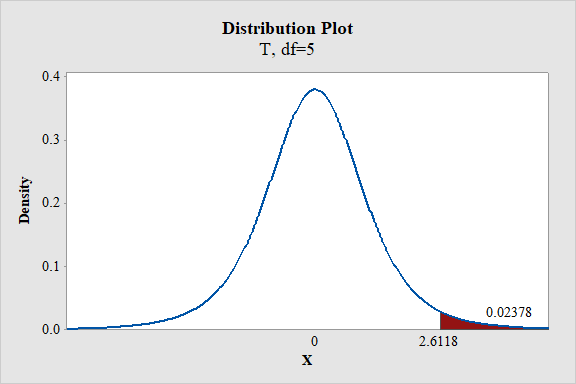
a.
State the null and alternate hypotheses.
a.
Answer to Problem 2CYU
The hypotheses are given below:
Null hypothesis:
That is, there is no significant difference between the mean amount of rainfall of a city in year2 and year1.
Alternate hypothesis:
That is, the mean amount of rainfall of the city in year2 is greater than the mean amount of rainfall of the city in year1.
Explanation of Solution
The data represents the mean amount of rainfall of a chosen city in two consecutive years (year2 and year1).
Hypothesis:
Hypothesis is an assumption about the parameter of the population, and the assumption may or may not be true.
Let
Claim:
Here, the claim is, whether the mean amount of rainfall of the city in year2 is greater than the mean amount of rainfall of the city in year1.
The hypotheses are given below:
Null hypothesis:
Null hypothesis is a statement which is tested for statistical significance in the test. The decision criterion indicates whether the null hypothesis will be rejected or not in the favor of alternate hypothesis.
That is, there is no significant difference between the mean amount of rainfall of a city in year2 and year1.
Alternate hypothesis:
Alternate hypothesis is contradictory statement of the null hypothesis
That is, the mean amount of rainfall of the city in year2 is greater than the mean amount of rainfall of the city in year1.
b.
Compute the differences in amount of rainfalls Year2– Year1.
b.
Answer to Problem 2CYU
The differences in amount of rainfalls Year2– Year1 is,
| S.no | |
| 1 | 9.5 |
| 2 | 3.4 |
| 3 | –3.8 |
| 4 | 10.1 |
| 5 | 8.9 |
| 6 | 5.7 |
Explanation of Solution
Calculation:
The differences in amount of rainfalls Year2– Year1 is,
| S.no | Year2 | Year1 | |
| 1 | 34.6 | 25.1 | |
| 2 | 18.7 | 15.3 | |
| 3 | 42.6 | 46.4 | |
| 4 | 41.3 | 31.2 | |
| 5 | 60.6 | 51.7 | |
| 6 | 29.9 | 24.2 |
c.
Find the value of t-test statistic.
c.
Answer to Problem 2CYU
The value of test statistic is 2.6118.
Explanation of Solution
Calculation:
Test statistic:
The test statistic for matched pairs is obtained as,
where
matched pairs and
Mean and standard deviation of differences:
Software procedure:
Step-by-step procedure to obtain the mean and standard deviation using the MINITAB software:
- Choose Stat > Basic statistic > Display
descriptive statistics . - In Variables, enter the column of Differences.
- In Statistics, select mean, standard deviation and N total.
- Click OK.
Output using the MINITAB software is given below:

From the MINITAB output, the mean and standard deviation are 5.63 and 5.28.
The mean and standard deviation of the differences is 5.63 and 5.28.
Here, the sample size is
The test statistic is obtained as follows,
Thus, the test statistic is 2.6118.
d.
Find the P-value for the test statistic.
d.
Answer to Problem 2CYU
The P-value for the test statistic is 0.02378.
Explanation of Solution
Calculation:
Degrees of freedom:
The degrees of freedom for the test statistic is,
Thus, the degree of freedom is 5.
P-value:
Software procedure:
Step-by-step procedure to obtain the P-value using the MINITAB software:
- Choose Graph > Probability Distribution Plot.
- Choose View Probability > OK.
- From Distribution, choose ‘t’ distribution.
- In Degrees of freedom, enter 5.
- Click the Shaded Area tab.
- Choose X value and Right Tail for the region of the curve to shade.
- In X-value enter 2.6118.
- Click OK.
Output using the MINITAB software is given below:

From the MINITAB output, the P-value is 0.02378.
Thus, the P-value is 0.02378.
e.
Interpret the P-value at the level of significance
e.
Answer to Problem 2CYU
There is enough evidence to reject the null hypothesis
Explanation of Solution
From part (d), the P-value is 0.02378.
Decision rule based on P-value:
If
If
Here, the level of significance is
Conclusion based on P-value approach:
The P-value is 0.02378 and
Here, P-value is less than the
That is,
By the rejection rule, reject the null hypothesis.
Thus, there is enough evidence to reject the null hypothesis
f.
State the conclusion.
f.
Answer to Problem 2CYU
There is enough evidence to conclude that the mean amount of rainfall of the city in year2 is greater than the mean amount of rainfall of the city in year1.
Explanation of Solution
From part (e), it is known that the null hypothesis is rejected.
That is, mean amount of rainfall of the city in year2 is greater than the mean amount of rainfall of the city in year1.
Thus, there is enough evidence to conclude that the mean amount of rainfall of the city in year2 is greater than the mean amount of rainfall of the city in year1.
Want to see more full solutions like this?
Chapter 9 Solutions
ESSENTIAL STATISTICS(FD)
 MATLAB: An Introduction with ApplicationsStatisticsISBN:9781119256830Author:Amos GilatPublisher:John Wiley & Sons Inc
MATLAB: An Introduction with ApplicationsStatisticsISBN:9781119256830Author:Amos GilatPublisher:John Wiley & Sons Inc Probability and Statistics for Engineering and th...StatisticsISBN:9781305251809Author:Jay L. DevorePublisher:Cengage Learning
Probability and Statistics for Engineering and th...StatisticsISBN:9781305251809Author:Jay L. DevorePublisher:Cengage Learning Statistics for The Behavioral Sciences (MindTap C...StatisticsISBN:9781305504912Author:Frederick J Gravetter, Larry B. WallnauPublisher:Cengage Learning
Statistics for The Behavioral Sciences (MindTap C...StatisticsISBN:9781305504912Author:Frederick J Gravetter, Larry B. WallnauPublisher:Cengage Learning Elementary Statistics: Picturing the World (7th E...StatisticsISBN:9780134683416Author:Ron Larson, Betsy FarberPublisher:PEARSON
Elementary Statistics: Picturing the World (7th E...StatisticsISBN:9780134683416Author:Ron Larson, Betsy FarberPublisher:PEARSON The Basic Practice of StatisticsStatisticsISBN:9781319042578Author:David S. Moore, William I. Notz, Michael A. FlignerPublisher:W. H. Freeman
The Basic Practice of StatisticsStatisticsISBN:9781319042578Author:David S. Moore, William I. Notz, Michael A. FlignerPublisher:W. H. Freeman Introduction to the Practice of StatisticsStatisticsISBN:9781319013387Author:David S. Moore, George P. McCabe, Bruce A. CraigPublisher:W. H. Freeman
Introduction to the Practice of StatisticsStatisticsISBN:9781319013387Author:David S. Moore, George P. McCabe, Bruce A. CraigPublisher:W. H. Freeman





